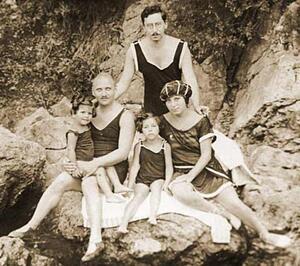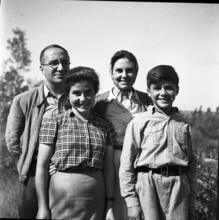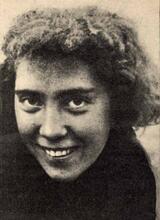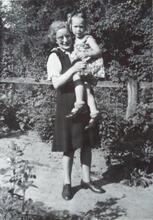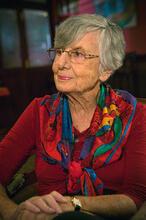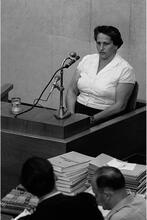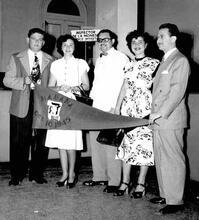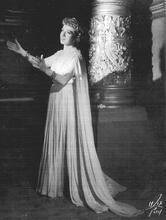Gisi Fleischmann
Gisi Fleischmann was born in Pressburg, Slovakia, in 1892. Though it was harder for women to obtain an education in that day, Fleischmann taught herself German literature, the history of art, and history, and developed natural leadership skills. Fleischmann soon became exposed to Zionism and joined WIZO of Slovakia, the Women’s International Zionist Organization. On the eve of World War II, Fleishmann had the opportunity to emigrate to Palestine, but she chose to stay and fight with the underground resistance. Fleishmann provided widespread underground correspondence and organizing rescue missions for children to flee to Palestine. Upon capture and arrival at Auschwitz, Fleishmann died in 1944.
Background
Zionist and public activist, a leader of the Slovakia Jewish community during the Holocaust, Gisi Fleischmann was born in Pressburg (later Bratislava, the capital of Slovakia). She was the eldest of three children born to Julius Fischer (1866–1936) and Jetty Elinger (1871–1945). Her parents, both born in Pressburg, ran a hotel and Term used for ritually untainted food according to the laws of Kashrut (Jewish dietary laws).kosher restaurant in that city. Her brothers were Desider David (1884–1973), a pediatrician, and Gustav (1886–1939), a doctor of law. The tendency of the time to give only boys an academic education left Gisi with only eight years of schooling, but that did not prevent her from teaching herself German literature, the history of art, and history. Nor did it prevent her from exercising her natural leadership abilities when the time came.
Her childhood years were also the final years of Hungarian control over the Slovaks, which had lasted for about a thousand years. The Magyarization of the nineteenth century, during which the Hungarians tried to turn Hungary into a country of one nationality, also turned the Jewish residents of Pressburg, where the Slovakians were a minority, into speakers of German and Hungarian. With the establishment of the Czechoslovakian Republic in 1918, the twenty-six-year-old Fleischmann became a citizen of a new state without being able to speak the local Slovakian language.
Zionism on the Eve of World War II
Her marriage in 1915 to the affluent Josef Fleischmann (1886–1942) resulted in two daughters: Alice (1917–1996), and Judith (1920–1997). At about this time, Gisi was exposed to Zionism, which as it spread encountered strong opposition from the Orthodox leadership even in Slovakia. Although her parents—and, indeed, the entire family—were members of this community, they did not prevent their children from turning their kosher restaurant in the city’s Jewish quarter into a central meeting place for supporters of Zionism.
Fleischmann’s public activity began in 1925 when she joined Julia Knoepfelmacher (1887–Auschwitz 1944), the founder of WIZO in Slovakia. Fleischmann quickly became vice president. Together with Hannah Steiner (1894–Auschwitz 1944) and Marie Schmolka (1890–London 1940), who were active in the Czech part of Czechoslovakia, Fleischmann harnessed herself to organize social work, educational activity, and pioneer training in Slovakia. Her leadership abilities came to the fore in her work with WIZO. At the organization’s international conventions, she made the initial contacts with women activists in other Jewish organizations from other countries. Upon the arrival of refugees from Germany after Hitler’s rise to power (1933), Fleischmann was among the first to respond to their distress. Her comprehensive assistance to them, which included organizing professional retraining, led to her first contacts with representatives of the Joint Distribution Committee in Prague and with its central leadership in Paris. In spring 1938, refugees from Austria began to stream into Slovakia. The leaders of HICEM (a combination of three leading immigrant-aid organizations: HIAS, the Hebrew Immigrant Aid and Sheltering Association; ICA, the Jewish Colonization Association; and Emigdirect), with Fleischmann among them, were among those who provided the most significant aid. They saved several dozen refugees from Burgenland, Austria, who lived in cramped, destitute conditions on the deck of a boat on the Danube, under Hungarian guard. They had been expelled from Austria as stateless persons, and Hungary and Slovakia refused to accept them. As a result of Fleischmann’s central role in rescue activities on their behalf in Bratislava, the refugees were saved and brought first to Slovakia and then to Palestine. Upon the outbreak of World War II, her intensive activity on behalf of refugees led to her becoming the representative of HICEM and the Joint in Slovakia.
Emigration to Palestine
The hard work she invested in London and Paris in an attempt to gain entrance visas for the many people who wished to emigrate proved fruitless because the western countries were not willing to accept Jews. In August 1939, she gently rejected her friends’ suggestion that she not return to Slovakia; since she saw herself as the representative of those who were seeking safe haven, she regarded her own salvation as out of the question.
Nazi policy on the eve of the Holocaust was to get rid of the Jews via emigration. Refugees who sought to go to Palestine continued to arrive in Bratislava. The rumor of the way to Palestine via the Danube river paved by local Zionist activists increased the flow of refugees. The many obstacles to organizing their legal or clandestine immigration compelled them to stay in Bratislava for long periods, in buildings that the community rented for them. Fleischmann was among those who cared for their physical needs and, to give them encouragement, their cultural needs as well.
Family Tragedy
Within a short time, several occurrences befell Fleischmann’s family that affected her greatly. Her mother came to live with her after being widowed. Parting from her daughters, whom she managed to send to Palestine in 1939, was very difficult for Fleischmann, despite knowing that she was sending them to a safer place. Antisemitic hooligans killed her beloved younger brother Gustav, and his wife Lily subsequently sank into depression and committed suicide in 1940. Fleischmann became widowed as well, and all this happened as anti-Jewish persecution was increasing and she was compelled to put increasing effort into her public activities.
Antisemitic Policies in Slovakia
In September 1940, the Slovak government was about to establish the Judenrat and, at the same time, outlaw all Jewish organizations. This decree caused great fear in Jewish circles. Even the Zionist leaders met to decide whether to join the forcibly established organization. Those who supported joining, among them Fleischmann—then already a member of the executive committee of the Zionist Federation—felt that the responsibilities of the Jewish community in Slovakia at that time did not allow them to stand aside, and that they had to act from within the organization, even a forced one, for their people’s benefit. The majority of Jews, including the Orthodox and Reform circles, accepted this opinion.
Responsibility for establishing the Judenrat, which in Slovakia was called Ústredňa Židov (ÚŽ, Jewish Center) and the staffing of its departments was placed upon the Orthodox community, who constituted a majority among the members of the local Jewish population. The secretary of the national Orthodox community, Heinrich Schwartz (1904–1943), took the role of “elder of the Jews.” Fleischmann was placed in the immigration department as a HICEM representative. With the Nazis’ abandonment of the emigration policy in autumn 1941, Fleischmann joined the management of the social welfare department. The exclusion of Jews from economic life and their eviction from their sources of livelihood rendered thousands destitute. Fleischmann had more than enough work.
In the spring of 1941, the authorities arrested Schwartz, who had tried to frustrate the execution of their decrees. He managed to escape to Hungary. Schwartz was replaced by Arpad Sebestyen (1878–1944), the principal of a Bratislava Jewish junior high school, who lacked experience in public activity. Sebestyen’s obedience in fulfilling the government’s orders and his submissiveness to UZ worker Karol Hochberg (1911–executed by Jewish partisans in 1944) caused increasing discontent among several workers who saw the latter as a collaborator with Adolf Eichmann’s deputy in Slovakia, SS officer Dieter Wisliceny (1911–tried and hanged in Bratislava in 1948). Fleischmann’s office, which was located in a separate building from that of the official leadership, became a place where other disaffected workers held spontaneous meetings to solve problems and make decisions about illegal activity. It is certain that what drew them there was not only the convenient location but also Fleischmann’s unique personality, since she won the admiration of other dedicated workers by her commitment to public activity, sagacity and balanced judgment. People of all trends were there: assimilationists, Zionists and ultra-Orthodox adherents. Later a smaller group called Pracovná Skupina (Working Group) evolved from these spontaneous meetings.
The authorities’ decision to set up labor camps on Slovakian soil was made in autumn 1941 and placed those ÚŽ workers concerned with matters of conscience in a dilemma as to whether to cooperate with this effort. Those who opposed it cited the danger to the people who would be concentrated in the camps if the threat of deportation was implemented. The supporters, Fleischmann among them, believed that productive labor camps that brought economic benefit to the country would support the moderates in the government, who favored the exploitation of the Jewish work force in Slovakia. Thus the camps were set up with the help of ÚŽ members, none of whom could have foreseen that the decision to deport the Jews, which was made so soon, in February 1942, had nothing to do with the existence of labor camps.
When news of this decision reached the members of the “Working Group,” they met to decide how to prevent its execution. Their failure to prevent the implementation of the decision despite using their best connections on all levels revealed how desperate their situation now was.
Flesichmann’s Leadership
The deep involvement of Rabbi Michael Dov-Ber Weissmandel (1903–1956) with the activists started at the beginning of summer 1942, when the transports were running full force. The despair everyone felt because of their helplessness in the face of the tragedy unfolding before their eyes led the rabbi to bribe Slovakian officials and Wisliceny to end the deportations. Over the strong opposition of her colleagues, Flesichmann accepted Weissmandel’s proposal to have Hochberg serve as the intermediary between themselves and Wisliceny.
Because of the sensitivity of the subject, a small group of those activists who opposed the official leadership had to be chosen for the bribery operation. Weissmandel suggested Fleischmann as the leader of the group—a proposal which was accepted unanimously, since “Gisi’s conducting of the orchestra had become a tradition,” according to Oskar (Yirmiyahu) Neumann (1894–1981), chairman of the Zionist Organization which worked underground at the time. Besides Fleischmann’s unique ability to win the trust of people with differing world views, Weissmandel took into account her connections with representatives of world Jewish organizations, knowing that their initiative would require a great deal of money.
From then on, Fleischmann’s main task involved widespread underground correspondence with Saly Mayer (1882–1950), the representative of the Joint Distribution Committee in Switzerland, Richard Lichtheim of the Jewish Agency, Natan Schwalb of He-Halutz in Switzerland and, later, with representatives of the Va’ad ha-Hazalah be-Kushta [Istanbul] (Rescue Committee of the Jewish Agency in Turkey). At the same time, she was active in many areas, though mainly in procuring aid for refugees and local people in need.
Europa Plan
Weissmandel’s belief that the bribery operation had stopped the deportation of Slovakian Jews in October 1942 encouraged him to persuade his skeptical colleagues to initiate, via Wisliceny, a plan to save all the Jews of Europe. Fleischmann supported this new initiative, which they called the Europa Plan, and began intensive correspondence with Jewish organizations. But she faced a great deal of tension because of the organizations’ inability to meet the payments they had taken upon themselves. The Allies’ prohibition on transferring money into enemy territory, the lack of such a large amount in the possession of the Joint representative from Switzerland, and perhaps also the skepticism of activists in the free world regarding the Europa Plan, all led to Fleischmann’s pleas for large amounts of money going unanswered. A decision to support the Europa Plan was taken only after pressure from those leaders of the Jewish community in Palestine prior to the establishment of the State of Israel. "Old Yishuv" refers to the Jewish community prior to 1882; "New Yishuv" to that following 1882.Yishuv who were in favor of the Plan and insisted upon endorsing it, even if the likelihood of its fulfillment was minimal. It was not lack of funds that served as the pretext for the stopping of negotiations in September 1943, which many felt had no chance of success even at the outset.
Along with efforts to stop the deportations in Slovakia and later on in Europe, the Working Group acted to find out the whereabouts of those who had been deported in order to offer help. They did this by employing trustworthy border-runners. Fleischmann and her colleagues supplied Jewish organizations abroad, including the Va’ad ha-Hazalah be-Kushta, with addresses of deportees so that they too would be able to help. Help continued from Slovakia as long as signs of life, however weak, came out of Poland.
Rescue Missions
News of the temporary moratorium on deportations spurred the Jews of Poland in the ghettos that were close to the border to flee to Slovakia in order to reach Hungary, which was safer. Working Group activists contributed all their strength, as well as their own border-crossing network, to this effort. Fleischmann advised the Jewish organizations about the border-crossing movement so as to obtain from them the large amount of funds to cover the costs of each escape. Several times the members of the rescue committee in Istanbul expressed their amazement at the Working Group and their ability to find new ways to aid and rescue the Jews of Poland under the threat of resumption of the deportations from Slovakia. The Va’ad ha-Hazalah committee called these connections “the only window to the site of the Holocaust.”
Fleischmann’s involvement in the Children’s Rescue Plan, which Wisliceny brought with him when he returned from Berlin at the beginning of September 1943, led twice to her arrest. By that time, Hochberg, who mediated between the Working Group and Wisliceny, had been arrested, and from the beginning of 1943, Fleischmann and her colleague Andrej Steiner (b. 1908) conducted direct talks with the German advisor. The Children’s Rescue Plan initiated by the leaders of the Yishuv led to its representatives in London bringing pressure to bear on the British government to implement the plan. As a result, the British government transmitted this proposal to the German foreign office via Anton Feldscher, the attaché at the Swiss legation in Berlin. The plan proposed transferring five thousand children from the Holocaust areas in exchange for German prisoners. Wisliceny informed Fleischmann that one thousand children had already been transferred from the Bialystok ghetto to that of Theresienstadt. Getting the children to Palestine via Slovakia required local preparation. Fleischmann’s bribing of the wife of Izidor Koso, director of the Ministry of the Interior, and her possession of a letter telling leaders of Jewish organizations in Switzerland to help Mrs. Koso, were supposed to eliminate the obstacles to this plan. The discovery at a border crossing of the letter in the possession of Koso’s wife led to Fleischmann’s arrest and interrogation and to her second arrest in January 1944, which lasted four months. The transfer to Auschwitz and subsequent killing of the Bialystok children held in Terezin took place before the Koso affair was exposed, proving that the discovery of the letter at the border had nothing to do with the failure of the children’s rescue plan.
Refusal to Give Up the Fight
Upon Fleischmann’s release, which resulted from intensive intervention, her colleagues tried to persuade her to emigrate to Palestine. The arrangements had been made, but despite Fleischmann’s worry and longing for her daughters there, she refused to give up the fight. Her feeling of commitment to the people and the clear knowledge of more difficult tests to come would not allow her to escape to the free world.
The deportation of Hungarian Jews began on the day of Fleischmann’s release from prison. Without taking a break, Fleischmann threw herself completely into efforts to bring back the children, who had been smuggled there because of the danger of their being deported from Slovakia. This would be done either “legally,” with the covert assistance of Ján Spišiak (1901–1981), the Slovak envoy in Budapest, or illegally, via border-runners. “We are looking for any way to bring the children to Naomi [Slovakia],” she wrote to Natan Schwalb the European representative in Geneva of He-Halutz after her release. “We cannot refrain from trying anything possible in this matter.” Yet more difficult challenges awaited those children and adults who managed to return to Slovakia between September 1944 and war’s end.
In the summer of 1944, the Hungarian Labor Zionist activist, Rezsö (Israel) Kasztner (1906–1957) the head of the Hungarian Rescue Committee, asked the Working Group for help in obtaining trucks and other materials which were part of the negotiations with the Germans for saving the remaining Hungarian Jews. The latter made their immediate response conditional upon Kasztner’s including the future of Slovakia’s surviving Jews in the negotiations. Without delay, Fleischmann gathered local Jews who had previously been wealthy and who still had connections. By Kasztner’s second visit, she already had a list of supplies that could be handed over immediately. The entry of the German army into Slovakia and the subsequent Slovakian national uprising from August 28–29 to October 27, 1944 eliminated any possibility of carrying out the plan.
German Occupation of Slovakia
The Germans took over the Jewish question from the new Slovakian government. With the help of loyal local collaborators, they began to capture Jews in the country towns and imprison them in the former Sered labor camp, which had been turned into a concentration camp. At that time, Fleischmann had the opportunity to go to a partisan-controlled area via a special delegate sent to take her to safety. As she had twice before, Fleischmann refused to abandon her mission and save herself despite the fact that her sick mother had already been removed to safety. On the night of September 28, 1944 there was an extensive raid on the Jews of the capital. About one thousand eight hundred Jews, including most of the Working Group, were captured and taken to Sered. SS officer Alois Brunner (b. 1912, still at large in Syria), who presided over the deportations, allowed Fleischmann and her colleague Tibor Kováč (1905–1952) to remain in their office at 6 Edlová Street (Edelgasse in German). Under the watchful eye of the SS, they were given the task of providing for the Jews imprisoned in Sered. The Gestapo headquarters was stationed in the very same building. On October 15, Fleischmann—alone in her office—was in the process of answering a Jew in hiding who had asked for help. She managed to write, “Regrettably, I am in the lion’s mouth,” before the door was thrown open by an SS officer. Tearing the letter to pieces was of no avail. At Brunner’s order, she was taken immediately to Sered, where she was promised release in exchange for the names of Jews in hiding. She endured the difficult interrogations with courage. This became known to her colleague, Oskar Neumann, who by that time was also in Sered and who managed to meet her secretly under cover of night. Two days later, on October 17, Fleischmann was included in the last transport from Slovakia to the Auschwitz death camp. (On Himmler’s orders, killing by gas was stopped at the end of October, and the obliteration of the traces of genocide began.) On Brunner’s explicit order, the letters R. U. (Rückkehr unerwünscht—return undesirable) were added to her name on the list. When the train carrying her arrived at Auschwitz, two names were called out on the loudspeaker. Fleischmann’s was one of them. According to a Slovakian survivor’s eyewitness account, she was taken away by two SS officers and never seen again.
Her elderly, sick mother survived the war only to suffer for several more months over her beloved daughter’s “inexplicable silence.” To the day of her death, she never learned the reason.
Fleischmann’s life and public activity rendered her an outstanding and admired figure in the history of Slovakian Jewry.
Bauer, Yehuda. Jews for Sale?: Nazi-Jewish Negotiations, 1933–1945. New Haven: Yale University Press,1994
Campion, Joan. In the Lion’s Mouth: Gisi Fleischmann and the Jewish Fight for Survival. Maryland: University Press of America,1987
Fatran, Gila. Struggle for Surviving?: Jewish Leadership in Slovakia during the Holocaust, 1938–1944 (Hebrew). Tel Aviv: 1992
Jablonka, Chana. “Gisi Fleischmann.” In The History of the Jewish Holocaust in Slovakia (Hebrew). edited by Akiva Nir. Givat Havivah: 1988
Kafri, Haim. “Gisi Fleischmann: A Fighter and Savior in Slovakia during World War II” (Hebrew). Yalkut Moreshet 13. Tel Aviv: 1971
Neumann, Oskar Yirmeyahu. Gisi Fleischmann: Die geschichte einer Kaempferin. Tel Aviv: 1970.
Porat, Dina. The Blue and the Yellow Star of David: The Zionist Leadership of Palestine and the Holocaust, 1939–1945. Harvard University Press: 1990.

